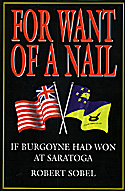 Published by Greenhill Books, 1997.
Published by Greenhill Books, 1997.
hardbound, ISBN: 1-85367-281-5
441 pages, plus 1 map, appendices, Bibliography, Index.
During the American Revolution, or American War of Independence if you prefer, a heavily outnumbered British force commanded by General John Burgoyne surrendered to the Americans. This victory helped convince France to support the fledgling nation and ultimately provide men and material to defeat the British.
For Want of a Nail offers an alternative version of history, where British reinforcements do arrive on the New York battlefield, and American General Horatio Gates' force is encircled, smashed, and scattered. Meanwhile, British General Howe marches on Philadelphia, defeats Washington and captures the city. Desertions from the winter encampment at Valley Forge weaken the rebels, Washington is essentially sacked (although officially he resigns and returns to Mount Vernon), and negotiations begin to end the rebellion.
From the time of the victory on page 31 to the end of the alternative history narrative on page 401, Sobel hooks you with details small and large. For example, in explaining a small part of the aftermath of the North American War of Rebellion ended by treaty on June 12, 1778, Sobel postulates:
- Of the 56 men who signed the Declaration of Independence in 1776, only seven were taken to London for trial and subsequently executed...
Footnote 2:This group consisted of: John Adams, Sam Adams, John Hancock, Thomas Jefferson, Richard Henry Lee, Robert Treat Paine, and Roger Sherman. In addition, Tom Paine and Patrick Henry were also put to death. George Washington was tried, found guilty, and sentenced to life imprisonment. Benjamin Franklin, 73 years old at the time, was not put on trial in deference to his age, previous contributions to science, and aid in bringing fighting to a close. He did not return to America, taking up residence in London where he died in 1781. (page 38)
This is certainly a valid point to make and Sobel makes a considerable number of them in his speculative history. The farther you read into the book, the more speculative it becomes. The earlier chapters are the most riveting, in part because they are based on the most historical evidence. As the book continues, Sobel's vivid imagination inevitably takes greater hold of the narrative.
Woven Web
The use of footnotes and source material--some obviously works of fiction, others not so obvious--prove to bring the material into focus as if you were reading a real history book. Indeed, Sobel does such a fine job of footnoting, embedding a variety of statistical analysis, and inserting quotes, there is a danger that you forget that this is a work of speculation. It is impossible to distinguish real from fictional books, and I admit that the books quoted may or may not actually exist--only the librarian of Congress knows for sure.
Even cleverer is the weaving of historical personnas and events into the narrative, sort of a reverse Forrest Gump. In the movie and book, the fictional Gump interacts against real events. In For Want of a Nail, real characters interact against fictional events. As always, Sobel includes a twist:
- The most innovative of all North Americans made his impact felt towards the end of this period of great growth. Thomas Edison, born in Indiana in 1847, perfected Aaron Garfield's telegraph when only 20 years old, thus making long-distance transmission possible. Forming his own company, National Union, Edison won the contract for the construction of the Burgoyne [capital city of Confederation of North America--as Sobel refers to the post-war colonies] to Mexico City [capital of the rival United States of Mexico, created in part from ex-war leaders] linkage, which was completed in 1876. (page 143)
This passage is footnoted with a reference to James Queen, North America's Age of Genius: 1855-1880 (London, 1959). Real? Fake? Certainly Edison was born in 1847, and among his accomplishments was the 1870s invention of "diplex telegraphy" allowing the carrying of four messages with one wire. Is there a book by a James Queen? I wouldn't hazard a guess, but that's the beauty of For Want of a Nail. It reads as if it is the real history.
By the way, Edison, in Sobel's version, invents "vitavision, the locomobile, and the airmobile between 1898 and 1903" but has a fatal accident in 1903. In reality, Edison lived to 1931.
Postulation
Sobel continues to deliver his alternative fiction, citing political races, wars, industrial production, and all the other ideas and events you'd expect from a general history book. If his prose is not always riveting, his speculation carries on with verve, unfolding a chain of events across North and Central America into the early 1900s, through the Global War (World War II) of the 1940s, across the post-war 50s and 60s and to 1971 (the book was copyrighted in 1973).
By the end of the book, a sort of breathless pause engulfs the end of the last chapter. Then comes a critique from a professor--arguably the nail that was missing 400 pages ago. Like the rest, it is fictional critique of a fictional work, but it does point to the first three chapters as key to the book. And so they are.
Back to List of Book Reviews: General Topics
Back to Master Book Review List
Back to Master Magazine List
© Copyright 1997 by Coalition Web, Inc.
This article appears in MagWeb (Magazine Web) on the Internet World Wide Web.
Other military history articles and gaming articles are available at http://www.magweb.com